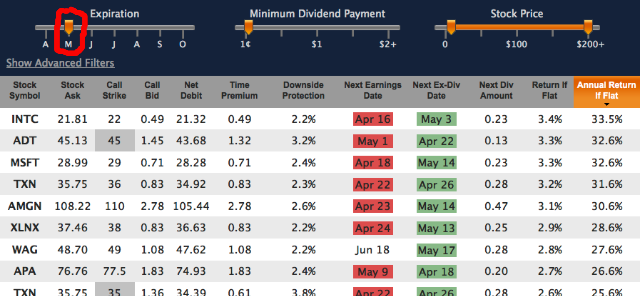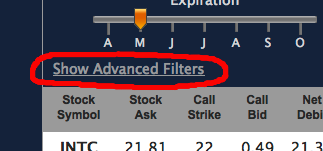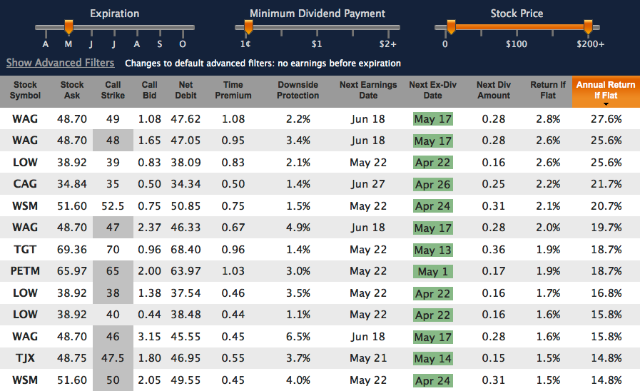Dividend Capture Without Earnings Risk
Dividend capture is an investment strategy where you purchase a stock prior to its ex-dividend date and then hold it until the ex-dividend date or later so that you will capture the dividend.
Earnings risk is the extra volatility many stocks experience when earnings are released.
The minimum holding period to receive a dividend is 1 night. You must own the stock at the close of the market the day before the ex-dividend date in order to receive the dividend. Even if you sell the stock at the open the next morning, on the ex-dividend date, and even if the payment date is later than the ex-dividend date, you will still receive the dividend if you owned the stock at the close on the day before the ex-dividend date.
For example, imagine a stock goes ex-div on May 17. You purchase shares on May 16 and sell them on May 17. You will get the dividend (although it may not be credited to your account for a few days).
Dividend Capture With Covered Calls
A common strategy is to combine dividend capture with call writing. You earn money two ways: (1) dividend and (2) time premium from the covered call. All you need is a list of stocks that have ex-dividend dates prior to whichever option expiration date you're interested in.
But there's a potential problem -- to reduce risk you probably want to eliminate covered calls where there is an earnings release date prior to the option expiration date. That's a lot of ex-div and earnings dates to look up. However, our screener makes it a snap. Here's how...
Screening For Dividends Without Earnings Risk
First, go to the Dividends submenu of the Search menu:

The Dividends page shows you the complete list of all covered calls that have an ex-dividend date prior to the Expiration you select.
Let's set Expiration slider to May:

Notice all the green dates in the Next Ex-Div Date column. All of these covered call results have an ex-div date prior to the May 18 option expiration date.
The only issue with this list is all those red dates in the Next Earnings Date column. That means those stocks have an earnings release prior to May 18. Lots of potential risk.
To remove everything that has an earnings release before the option expiration date, we go into the Advanced Filters:

and uncheck Earnings Before Expiration:

Now there are no more red dates:

That's it. With a couple of clicks, you've found a whole bunch of candidates for your dividend capture strategy, all of them yielding between 1.2% and 2.4% per month (the annualized rate divided by 12).
If you are conservative you'll want to look at the rows that have a dark grey background in the Call Strike column -- those are in-the-money options (where the strike is lower than the current stock price) that have more downside protection. The Annualized Return If Flat column shows you the annualized return if the stock's price remains unchanged (i.e. is flat) between today and May 18 (and it assumes that you receive the dividend, too).
Disclaimer: These are not meant to be trade recommendations. Just a filtering strategy to provide some ideas and candidates for further research. Do your homework.
Early Exercise With Covered Calls And Dividends
There is a risk that the person who bought the call option you shorted will exercise it the day before the ex-div date so that he gets your shares (and, therefore, the dividend) instead of you. However, it only makes economic sense for him to do this if the time premium remaining in the option is zero (and if the time premium is not zero then he'd be better off selling the option instead of exercising it). The only time that time premium might be zero is if the ex-div date is very near the option expiration date. Early exercise does happen but it is pretty rare (see ex-div dates and early exercise).
Dividend Capture Video
Here's a short video of the dividend capture tool in action, including the Minimum Dividend Payment slider (turn your sound on before playing):
Want dividends without earnings risk? Check Out Our Screener
Mike Scanlin is the founder of Born To Sell and has been writing covered calls for a long time.
